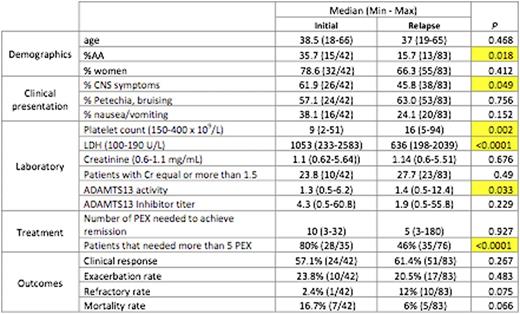Abstract
Background:
Thrombotic thrombocytopenic purpura (TTP) is characterized by consumptive thrombocytopenia and microangiopathic hemolytic anemia. At least a third of the patients with TTP will have one or more relapses throughout their life. There is very little data regarding the differences, if any, in clinical presentation and outcomes between the initial and subsequent TTP episodes. This information is relevant to understand if patients that present initially and those that present with a relapse can be seen as equal when being considered for clinical trials. Identifying the characteristics of patients that are prone to relapse will help guide the monitoring of patients after an acute episode of TTP to help to prevent relapse.
Methods:
Between March 2003 and June 2016 we collected clinical and laboratory data on all patients that presented to the Ohio State University with a diagnosis of acquired TTP (aTTP). The diagnostic criteria for aTTP included: thrombocytopenia, and a microangiopathic hemolytic anemia without an alternative explanation. The diagnosis was confirmed by the finding of severely deficient ADAMTS13 activity (<10%). Patients were consented to participate in our TTP registry and the information obtained included initial clinical presentation, platelets, LDH, kidney function, ADAMTS13 activity and inhibitor titer, number of plasma exchange (PEX) to achieve remission (defined as number of PEX needed to obtain a normal platelet count), and the outcome of the episode; clinical response (normal platelet count and LDH), exacerbation (recurrent TTP within 30 days of last PEX procedure), refractory (more than 30 PEX needed to obtain a clinical response), or death.
Results:
- All the patients enrolled were included in the study, except those with active cancer, leaving a total of 125 episodes from 57 patients.
- 36 of the 57 patients had two or more TTP episodes (relapse rate 63.1%), with 21 of the 57 patients having 3 or more episodes. The time between episodes varied greatly, from 2 months to 8 years.
- Of the 125 episodes, there were 42 initial and 83 relapses.
- The initial group presented with central nervous system (CNS) symptoms more commonly than the relapse group. They also had significantly lower platelets and a higher LDH than the relapse group.
- Regarding treatment, there was no significant difference in the number of PEX needed to achieve remission between the 2 groups. However, there was a significant number of patients in the initial group that needed more than 5 PEX to achieve remission, compared to the relapse group (p<0.0001)
- There were no significant differences in the main clinical outcomes between the initial and relapse groups in rates of clinical response (p=0.267), exacerbation (p=0.483), refractory (p=0.075) or death (p=0.066)
Conclusions:
In their first episode of TTP, patients may present more ill than those patients having relapses (with more CNS symptoms, lower platelets and higher LDH), and may also require more PEX sessions to achieve remission. However, these findings do not change outcomes, and patients in their initial presentation and relapses can be seen as equal in terms of clinical response, exacerbation, refractory disease, and mortality rates. The high relapse rate seen in our registry may be due to the prolonged follow up (13 years) which is more than other series reported. Patients may have a relapse even after several years of being stable.
No relevant conflicts of interest to declare.
Author notes
Asterisk with author names denotes non-ASH members.



This feature is available to Subscribers Only
Sign In or Create an Account Close Modal